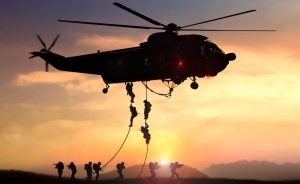You’ve probably seen them in movies and heard the legendary stories. Two of the most elite forces in the world are the U.S. Army Green Berets and the Navy SEALs. But what really separates them?
Looking at the matchup of Army Green Beret vs Navy SEAL is more than just a debate; it’s about understanding two very different, very specialized groups of warriors. These operators are the tip of the spear for U.S. special operations forces. They go where others can’t and do what others won’t.
So, we’re going to break down the real story behind the Green Berets and Navy SEALs comparison, looking at their missions, training, and what makes each force tick.
Need Expert Help With Your VA Disability Claim? Deserve Higher Disability Rating?

Table of Contents:
- Who Are the Army Green Berets?
- Who Are the Navy SEALs?
- The Gauntlet: A Look at Selection and Training
- Mission Focus: Army Green Beret vs Navy Seal
- Key Differences at a Glance
- Deployment and Lifestyle
- Conclusion
Who Are the Army Green Berets?
Army Special Forces are better known by their iconic headwear, the green beret. They are the U.S. Army’s experts in unconventional warfare. This makes them fundamentally different from almost any other special operations unit.
Their motto, De Oppresso Liber, means To Free the Oppressed. This perfectly captures their core mission. They are trained not just to fight but also to teach and lead, often working within a multinational force.
History and Formation
The Green Berets trace their roots back to unconventional units like the Office of Strategic Services (OSS) during World War II. The official 10th Special Forces Group was formed in 1952 to conduct guerrilla warfare behind enemy lines. President John F. Kennedy was a huge supporter of Army Special Forces, authorizing their signature green beret as their official headgear.
He saw their value in the global political climate of the Cold War and the Vietnam War. They could operate in the shadows, building relationships and capacity with partner nations. Their legacy was forged in the jungles of Southeast Asia, where they earned the nickname “snake eaters” for their survival skills.
The Quiet Professionals’ Mission
The primary mission of the Green Berets is unconventional warfare. They go into foreign countries and train local forces to fight for themselves. This core competency is what makes the Army Special Forces the principal special operations force for this type of work.
Their work requires incredible patience and cultural understanding, earning them the name “quiet professionals”. They learn languages, customs, and how to build rapport with people from completely different backgrounds. As the U.S. Army states, this is their bread and butter, a mission known as foreign internal defense.
Of course, they are also experts in direct action, special reconnaissance, and counter-terrorism. But their ability to work with and through indigenous forces is what truly sets them apart. Their standard unit, the 12-man Operational Detachment Alpha or ODA, is built for these long-duration missions, which can also include humanitarian missions.
Who Are the Navy SEALs?
The Navy Sea, Air, and Land Teams, or SEALs, are the U.S. Navy’s premier special operations force. They are known for their grit, toughness, and ability to operate in any environment. They are the masters of the maritime domain and direct action missions.
The SEALs were officially formed in 1962, also under President Kennedy. He recognized the need for a naval commando force that could conduct special warfare from the sea. Their predecessors were the formidable Underwater Demolition Teams of World War II, who cleared beaches for amphibious landings.
Forged by Sea, Air, and Land
SEALs are legendary for their amphibious capabilities. They can strike from the ocean, conduct beach reconnaissance, and destroy targets in coastal areas. Their very name speaks to their operational flexibility across sea, air, and land environments.
They can be inserted by submarine, helicopter, or high-altitude parachute jump. This makes them a highly adaptable and lethal force. This capability in maritime special operations allows them to get to places no one else can.
The SEALs’ Operational Mandate
While Green Berets focus on training foreign forces, SEALs are primarily a direct action unit. This means their job is to conduct short, violent raids and offensive actions. They are surgical strikers, a role that defines Naval Special Warfare.
The official SEAL and SWCC website highlights primary missions like special reconnaissance and counter-terrorism. High-profile operations have cemented their reputation as one of the world’s most effective counter-terror units. They go in, hit the target, and get out, as demonstrated in operations from the Achille Lauro hijacking to Operation Urgent Fury.
The Gauntlet: A Look at Selection and Training
To join either of these units, a candidate has to endure some of the toughest military training ever created. The attrition rates are sky-high for a reason. Only the strongest physically and mentally make it through.
Both selection processes are designed to strip candidates down to their core. They find out who will quit and who will push past their perceived limits. The mind is often the first thing to break, not the body.
Becoming a Green Beret: The Q Course
The path to earning the Green Beret is a long one, starting with the Special Forces Assessment and Selection (SFAS). This is a grueling 24-day course that tests physical fitness, teamwork, and problem-solving under extreme stress. It filters out those not suited for the intellectual and physical demands of the job.
If a candidate is selected, they move on to the Special Forces Qualification Course, or the “Q Course.” This can last from 6 months to over a year, depending on their assigned specialty, like weapons, engineering, medicine, or communications. Training includes language, culture, small unit tactics, and advanced skills specific to their role in an operational detachment.
This long training pipeline emphasizes intellectual and interpersonal skills just as much as tactical prowess. This differs from the training an Army Ranger in the Ranger Regiment receives, which is more focused on direct action. Green Berets need to be thinkers and teachers as well as fighters.
Becoming a Navy SEAL: BUD/S and SQT
The SEAL training pipeline is legendary for its brutality. It begins with Basic Underwater Demolition/SEAL training, or BUD/S. BUD/S is a 24-week trial by fire that is famously difficult and has a washout rate that often exceeds 75%.
The most notorious part of BUD/S is “Hell Week.” This is five and a half days where candidates get maybe four hours of total sleep while running more than 200 miles. They are constantly cold, wet, hungry, and pushed to their absolute physical and mental breaking points, truly living the mantra that the only easy day was yesterday.
After BUD/S, candidates go to SEAL Qualification Training (SQT). This is a 26-week course where they learn advanced skills like marksmanship, demolitions, combat diving, and tactics. The entire process weeds out all but the most resilient, producing operators for a SEAL Team who are masters of their craft.
Mission Focus: Army Green Beret vs Navy SEAL
Here is where the core differences between the two special operations forces become very clear. While both are part of the U.S. Special Operations Command (SOCOM), their job descriptions are distinct. They are different tools for different problems.
You wouldn’t send a hammer to do a screwdriver’s job. Likewise, you wouldn’t send SEALs to do a Green Beret’s long-term training mission. Understanding this is vital to the Army Green Beret vs Navy SEAL question.
Unconventional Warfare Specialists
Green Berets are the DOD’s masters of Unconventional Warfare (UW) and Foreign Internal Defense (FID). FID involves helping a host nation defend itself against threats. This means embedding with local troops for months or even years at a time.
They live with, train with, and sometimes fight alongside their foreign counterparts. This requires a level of cultural adaptability and maturity that is central to the Green Beret identity. Their primary weapon is influence and rapport, backed by force when necessary to achieve foreign internal defense goals.
Direct Action and Special Reconnaissance
Navy SEALs are SOCOM’s maritime experts and a premier direct action force. Their missions are often swift, violent, and focused on a specific objective. They excel at raids, ambushes, hostage rescues, and counter-drug operations.
Their operational tempo is very different from that of the Green Berets. A seal team platoon deploys, executes missions, and returns to base. Their focus is less on long-term relationship building and more on immediate, decisive action as part of naval special warfare operations.
This specialization in special reconnaissance direct action makes them an incredibly valuable asset for the operations command. They are the force tasked with taking down high-value targets. This has been their role since their inception and was honed during the Vietnam War.
Key Differences at a Glance
Sometimes the easiest way to see the differences is to lay them out side-by-side. Both are elite operations forces, but their focus and structure are not the same. This table simplifies the big picture of their roles within the larger special warfare command.
| Attribute | Army Green Berets | Navy SEALs |
|---|---|---|
| Branch | U.S. Army | U.S. Navy |
| Core Mission | Unconventional Warfare, Foreign Internal Defense | Direct Action, Special Reconnaissance |
| Parent Command | Army Special Operations Command (USASOC) | Naval Special Warfare Command (NSWC) |
| Primary Training | Special Forces Qualification Course (Q Course) | Basic Underwater Demolition/SEAL (BUD/S) |
| Team Size | 12-man Operational Detachment Alpha (ODA) | 16-man SEAL platoon (can split into smaller units) |
| Typical Deployment | Long-term, embedded with foreign forces | Shorter-term, mission-based deployments |
Deployment and Lifestyle
The day-to-day life and deployment cycle for a Green Beret and a Navy SEAL look quite different. This is a direct result of their differing primary missions. It shapes their careers and home lives, whether on active duty or in the National Guard.
A Green Beret on a 12-man ODA might spend a year deployed to a small village in Africa or South America. They become part of the community, building trust and training a local partner force. This is a slow, methodical process that requires a special kind of person with deep cultural awareness.
A Navy SEAL might deploy with a platoon on a naval ship or to a forward operating base. From there, they conduct a series of high-stakes missions over several months. It’s a faster pace with more explosive moments of action, typical of maritime special operations.
Conclusion
So who wins in a face-off? That’s the wrong question to ask. Both the Green Berets and the Navy SEALs are incredible assets to the United States military, filled with some of the most dedicated professionals on the planet.
They are not rivals but partners in the special operations community under a unified operations command. A SEAL platoon might need Green Berets to help them understand the local human terrain before a mission. A Green Beret team might call on SEALs for their specialized skills in combat diving or other Navy special warfare capabilities.
They represent two sides of the same elite coin, each with a mission that is vital to national security. Ultimately, the discussion of Army Green Beret vs Navy SEAL shows that America has the right tool for any job, no matter how difficult. The Green Berets and Navy SEALs are both powerful examples of what American special operations forces can accomplish.
Want more military info? Find your nearest military recruiter here!
